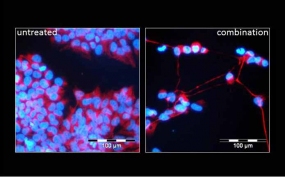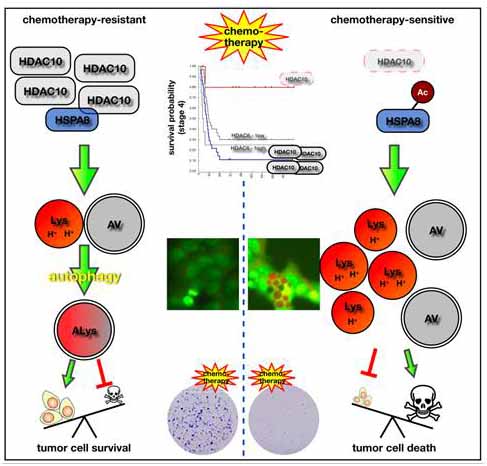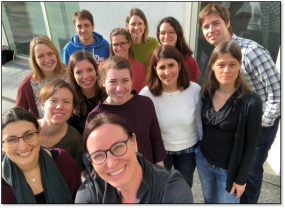The role of individual histone deacetylases in neuroblastoma and medulloblastoma cell death and differentiation
- Projects
- 1.1 Histone deacetylase 8 in neuroblastoma tumorigenesis
- 1.2 Targeting of histone deacetylase 2 enhances apoptosis in MYCN-amplified neuroblastoma cells
- 1.3 Histone deacetylase 10 promotes autophagy-mediated cell survival
- 1.4 Three-dimensional tumor cell growth stimulates autophagic flux and recapitulates chemotherapy resistance
- Funding
- Cooperation Partners
- Patent
- Key references
Staff
- Dr. phil. nat. Ina Oehme (Group leader)
- Dr. rer. nat. Heike Peterziel (Scientist)
- Dr. Jagoda Wrobel, PhD (Scientist)
- Dr. Sina Oppermann, PhD (Scientist)
- Emily Koeneke (PhD student)
- Johannes Ridinger (PhD student)
- Sara Najafi (PhD Student)
- Lisa Rösch (PhD Student)
- Fiona Kolbinger (MD student)
- Katharina Körholz (MD student)
- Michael Müller (MD student)
- Aileen Mangang (Technician)
- Alexandra Stroh-Dege (Technician)
Former lab members
- Ramona Straub (Technician)
- Dr. Jing Shen (PhD student)
- Annika Bittmann (Technician)
- Dr. sc. hum. Inga Rettig (PhD student)
- Dr. rer. nat. Johannes Fabian (Postdoc)
- Patricia Arnaiz (Master Student)
- Franziska Trippel (Master student)
- Sina Zimmermann (Diploma student)
- Corinna Bingel (Bachelor student)
- Philip Gunkel (Bachelor student)
- Diana Pickert (Bachelor student)
- Anne Vogel (Bachelor student)
- Jan-Peter Linke (MD student)
- Andreas Lacher (Technician)
- Cornelia Rütz (Technician)
Projects
For differentiation-defective malignancies, compounds that modulate transcription, such as retinoic acid and histone deacetylase (HDAC) inhibitors are of particular interest. HDAC inhibitors are currently under investigation for the treatment of a broad spectrum of cancer diseases. However, one clinical drawback is class-specific toxicity of unselective inhibitors, limiting their full anti-cancer potential. Selective targeting of individual HDAC isozymes in defined tumor entities may therefore be an attractive alternative treatment approach.
1.1 Histone deacetylase 8 in neuroblastoma tumorigenesis

Figure 1: Combined treatment of neuroblastoma cells with HDAC8 inhibitors and retinoic acid. Immunofluorescent pictures show the outgrowth of neurite-like structures that stain positive for neurofilament (red). Cells were counterstained with the nucleus-staining dye DAPI (blue). Neuroblastoma cells were treated for six days with a combination of HDAC8 inhibitor and retinoic acid.
© dkfz.de
We have identified HDAC family member 8 (HDAC8) as a novel target in childhood neuroblastoma. The development of neuroblastoma, the most common extracranial solid tumor of childhood, is hypothesized to be related to maturation defects of neural crest derived precursor cells of the peripheral sympathetic nervous system. The long-term overall survival probability of high-risk neuroblastoma patients is less than 50%.
Inhibition of HDAC8 enzymatic activity with selective inhibitors exhibits anti-neuroblastoma activity. Selective HDAC8 inhibition leads to cell cycle arrest and differentiation in vitro and in vivo. Upon combination with retinoic acid, differentiation is enhanced (see Figure 1). Thus, selective HDAC targeting can be effective in tumors exhibiting HDAC isozyme dependent tumor growth and can be combined with differentiation-inducing agents. Future investigations will focus on the use of selective HDAC8 inhibitors as anti-neuroblastoma drugs on the one hand; on the other hand, we will use the selective inhibitors as a tool to further understand the mechanistic background of HDAC8 mediated malignancy of neuroblastoma. In addition, we will investigate cooperating signalling pathways using synthetic lethal screening approaches.
1.2 Targeting of histone deacetylase 2 enhances apoptosis in MYCN-amplified neuroblastoma cells
The use of pan-histone deacetylase (HDAC) inhibitors on neuroblastoma cells have demonstrated that HDACs are involved in tumor biological processes such as cell cycle control, differentiation and apoptosis. One of the most frequent molecular events in neuroblastoma oncogenesis is the amplification of the MYCN oncogene. HDAC2 has been identified to be directly involved in the MYCN autoregulation mechanism in neuroblastoma cell lines. Under negative feedback conditions, HDAC2 is recruited to the MYCN promoter.
Knockdown of endogenous HDAC2 expression in neuroblastoma cell cultures results in an apoptotic phenotype. This supports our hypothesis that individual HDACs suppress different cancer relevant programs in a given tumor cell model. Future investigations will focus on the sensitivity of MYCN-amplified versus non-amplified neuroblastoma cells to the targeting of HDAC2.
1.3 Histone deacetylase 10 promotes autophagy-mediated cell survival
Autophagy is a cytoprotective mechanism that may help advanced cancer cells survive stressful conditions such as chemotherapy. We identified HDAC family member 10 (HDAC10) as a promoter of autophagy-mediated survival in neuroblastoma cells and propose this HDAC isozyme as a druggable regulator of advanced-stage tumor cell survival (see Figure 2). These results propose a new and promising way to considerably improve treatment response in patient subgroups with autophagy-dependent therapy resistance.

Figure 2 (Autophagy, Vol. 9, Issue 12, 2013): High expression of HDAC10 signals poor outcome in advanced-stage neuroblastoma patients, all receiving intense multimodal therapy. Enforced HDAC10 expression results in triggering of autophagy and protection of neuroblastoma cells from drug-induced cell death. Depletion as well as inhibition of HDAC10 leads to a sensitization of drug-resistant neuroblastoma cells but not untransformed cells for anticancer therapy. Depletion of HDAC10 abolishes fusion of autophagic vacuoles (AV) and lysosomes (Lys) and therefore blocks the formation of autolysosomes (ALys) and induces the accumulation of acidic vesicular organelles and autophagic vesicles. Mechanistically, HDAC10 interacts with HSP70 family proteins, which are involved in lysosomal functions, and the interaction of HDAC10 with HSPA8/HSP70 affects HSPA8/HSP70 acetylation (Ac) levels. Inhibition of HSPA8/HSP70 interaction with HDAC10 abolishes HDAC10-mediated protection of neuroblastoma cells against cytotoxic drug treatment. In the neuroblastoma context, HDAC6, the other class IIb family member, seems to play a minor role. Fluorescent image: red fluorescence after acridine orange staining indicates acidic organelles in HDAC10-depleted neuroblastoma cells. Crystal violet staining: longer-term colony assay depicting tumor cell survival.
© Autophagy, Vol. 9, Issue 12, 2013
1.4 Three-dimensional tumor cell growth stimulates autophagic flux and recapitulates chemotherapy resistance
Current preclinical models in tumor biology are limited in their ability to recapitulate relevant (patho-)physiological processes. Three-dimensional (3D) growth cultures have frequently been proposed to overcome the lack of correlation between two-dimensional (2D) monolayer cell cultures and human tumors in preclinical drug testing. Besides 3D growth, it is also advantageous to simulate shear stress, compound flux and removal of metabolites, e.g. via bioreactor systems, through which culture medium is constantly pumped at a flow rate reflecting physiological conditions. This platform (developed by Prof. Schober, TU Ilmenau) generates microtumors and enables more realistic drug testing. Moreover, the system allows for the identification of effective drug combinations to sensitize resistant tumor cells to treatment, which might become very useful in functional precision medicine. Thus, we plan to further optimize the system for medium throughput applications and primary tumor tissue cultures.

Figure 3: Recapitulation of chemotherapy resistance in microtumors (A) Principal Component Analysis of transcriptomes from 2D, 3D-static, 3D-bioreactor (3D-BR) cultures of neuroblastoma cells and three neuroblastoma patient samples (tissue). Neuroblastoma tissue samples and both kinds of 3D-cultured cells cluster together in the negative range of the x-axis and the transcriptomes of the 2D-cultured cells cluster in the positive range. (B) Neuroblastoma cells grown in monolayer (2D) or in 3D were treated 24 h post-seeding with doxorubicin in various concentrations for 48 h and IC50 values were calculated. (C) Scheme based on fluorescent staining, which illustrates different zones within the 3D structure and reflects unequal distribution of nutrients and drug to the different zones. Blue: Hoechst, green: autophagy (Cyto-ID). (D) BE(2)-C cells grown as monolayers under normal 2D conditions (left). Bioreactor and spheroidal 3D-cultured cell cluster (middle). Image of HE staining of neuroblastoma tissue (right). Small 3D bioreactor systems mimic the flow of extracellular fluids and compound flux by pumping medium at a physiologically-representative flow rate. The lower sensitivity to chemotherapy observed in these cultures more accurately recapitulates chemotherapy resistance of the real tumor than 2D-grown cells. Thus, the usage of more representative culture conditions could avoid a misleading prediction of drug sensitivity. Further reading: Bingel, Koeneke, Ridinger et al., CDDis 2017. Aug 24;8(8):e3013.
© CDDis 2017. Aug 24;8(8):e3013.
Funding
- H. W. & J. Hector Stiftung
- DFG
- DKFZ Development Fund
- Federal Ministry of Economics and Technology, Central Innovation Programme SME (ZIM)
- Wilhelm Sander-foundation
- Heinrich F.C. Behr stipend for MD students
Cooperation Partners
- HDAC8 selective inhibitors: Translational Research Pharmacyclics, Inc., Sunnyvale, USA
- New selective HDAC8/10 inhibitors: Institute of Pharmaceutical Sciences, Albert-Ludwigs-Universität Freiburg, Germany. Institute of Pharmacy, Martin-Luther-Universität Halle-Wittenberg, Halle, Germany
- German Neuroblastoma Trial: Dpt of Pediatric Oncology, University Children’s Hospital of Cologne, Germany
- New Cell Culture Technologies:Dpt. Nano-Biosystem Technology, Ilmenau University of Technology, Ilmenau, Germany
- DKFZ-internal cooperation partners:
- Lysosomal Systems Biology
- Systems Biology of Cell Death Mechanisms
- Division of Pediatric Neurooncology
- CCU Neuropathology, German Cancer Research Center
- Neuroblastoma Genomics, German Cancer Research Center
- Division Signaling and Functional Genomics, German Cancer Research Center
- Monoclonal Antibodies
Patent
- Oehme I, Brady N, Witt O. Histone deacetylase 10-inhibitor co-treatment in cancer. EP2610620 A1.
- Shen J, Koeneke E, Witt O, Kopp-Schneider A, Oehme I. Therapeutic combinations for use against neuroblastoma. EP14166679.2
Key references
1. Bingel C, Koeneke E, Ridinger J, Bittmann A, Sill M, Peterziel H, Wrobel JK, Rettig I, Milde T, Fernekorn U, Weise F, Schober A, Witt O, Oehme I. Three-dimensional tumor cell growth stimulates autophagic flux and recapitulates chemotherapy resistance. Cell Death Dis. 2017 Aug 24;8(8):e3013. doi: 10.1038/cddis.2017.398.
2. Rettig I, Koeneke E, Trippel F, Mueller WC, Burhenne J, Kopp-Schneider A, Fabian J, Schober A, Fernekorn U, von Deimling A, Deubzer HE, MildeT, Witt O, Oehme I. Selective inhibition of HDAC8 decreases neuroblastoma growth in vitro and in vivo and enhances retinoic acid-mediated differentiation. Cell Death Dis. 2015 Feb 19;6:e1657. Doi: 10.1038/cddis.2015.24.
3. Oehme I, Linke JP, Böck BC, Milde T, Lodrini M, Hartenstein B, Wiegand I, Eckert C, Roth W, Kool M, Kaden S, Gröne HJ, Schulte JH, Lindner S, Hamacher-Brady A, Brady NR, Deubzer HE, Witt O. (2013) Histone deacetylase 10 promotes autophagy-mediated cell survival. Proc Natl Acad Sci U S A 110(28):E2592-2601.
4. I. Oehme, M. Lodrini, N.R. Brady and O. Witt. Histone deacetylase 10-promoted autophagy as a druggable point of interference to improve the treatment response of advanced neuroblastomas. Autophagy, Vol. 9, Issue 12, 2013.
5. Fiegler N, Textor S, Arnold A, Rölle A, Oehme I, Breuhahn K, Moldenhauer G, Witzens-Harig M, Cerwenka A. Downregulation of the activating NKp30 ligand B7-H6 by HDAC inhibitors impairs tumor cell recognition by NK cells. Blood. 2013 Aug 1;122(5):684-93.
6. Lodrini M, Oehme I, Schroeder C, Milde T, Schier MC, Kopp-Schneider A, Schulte JH, Fischer M, De Preter K, Pattyn F, Castoldi M, Muckenthaler MU, Kulozik AE, Westermann F, Witt O, Deubzer HE. MYCN and HDAC2 cooperate to repress miR-183 signaling in neuroblastoma. Nucleic Acids Res. 2013 Jul;41(12):6018-33. doi: 10.1093/nar/gkt346. Epub 2013 Apr 26.
7. Dovzhanskiy DI, Arnold SM, Hackert T, Oehme I, Witt O, Felix K, Giese N, Werner J. Experimental in vivo and in vitro treatment with a new histone deacetylase inhibitor belinostat inhibits the growth of pancreatic cancer. BMC Cancer. 2012 Jun 8;12(1):226.
8. Milde T, Hielscher T, Witt H, Kool M, Mack SC, Deubzer HE, Oehme I, Lodrini M, Benner A, Taylor MD, von Deimling A, Kulozik AE, Pfister SM, Witt O, Korshunov A. Nestin Expression Identifies Ependymoma Patients with Poor Outcome. Brain Pathol. 2012 May 9.
9. Milde T, Kleber S, Korshunov A, Witt H, Hielscher T, Koch P, Kopp HG, Jugold M, Deubzer HE, Oehme I, Lodrini M, Gröne HJ, Benner A, Brüstle O, Gilbertson RJ, von Deimling A, Kulozik AE, Pfister SM, Martin-Villalba A, Witt O. A novel human high-risk ependymoma stem cell model reveals the differentiation-inducing potential of the histone deacetylase inhibitor Vorinostat. Acta Neuropathol. 2011 Nov;122(5):637-50.
10. Böck BC, Tagscherer KE, Fassl A, Krämer A, Oehme I, Zentgraf HW, Keith M, Roth W. The PEA-15 Protein Regulates Autophagy via Activation of JNK. J Biol Chem. 2010 Jul 9;285(28):21644-54.
11. Milde T, Oehme I, Korshunov A, Kopp-Schneider A, Remke M, Northcott P, Deubzer HE, Lodrini M, Taylor MD, von Deimling A, Pfister S, Witt O. HDAC5 and HDAC9 in medulloblastoma: novel markers for risk stratification and role in tumor cell growth. Clin Cancer Res. 2010 Jun 15;16(12):3240-52.
12. Oehme, I., Deubzer, H.E., Lodrini, M., Milde, T. and Witt, O. Targeting of HDAC8 and investigational inhibitors in neuroblastoma. Expert Opin Investig Drugs, 18: 1605-1617, 2009.
13. Oehme, I., Deubzer, H.E., Wegener, D., Pickert, D., Linke, J.-P., Hero, B., Kopp-Schneider, A., Westermann, F., Ulrich, S.M., von Deimling, A., Fischer, M. and Witt, O. Histone Deacetylase 8 in Neuroblastoma Tumorigenesis. Clinical Cancer Research 2009; 15: 91-99
14. Milde, T., Pfister, S., Korshunov, A., Deubzer, H.E., Oehme, I., Ernst, A., Starzinski-Powitz, A., Seitz, A., Lichter, P., von Deimling, A. and Witt, O. Stepwise accumulation of distinct genomic aberrations in a patient with progressively metastasizing ependymoma. Genes, Chromosomes and Cancer 2008; 48: 229-238
15. Oehme, I., Bösser, S., Zörnig, M. Agonists of an ecdysone-inducible mammalian expression system inhibit Fas Ligand- and TRAIL-induced apoptosis in the human colon carcinoma cell line RKO. Cell Death Differ 2006; 13: 189-201
16. Oehme, I., Neumann, F., Bosser, S., Zornig, M. Transgenic overexpression of the Caspase-8 inhibitor FLIP(short) leads to impaired T cell proliferation and an increased memory T cell pool after staphylococcal enterotoxin B injection. Eur J Immunol 2005; 35: 1240-9

